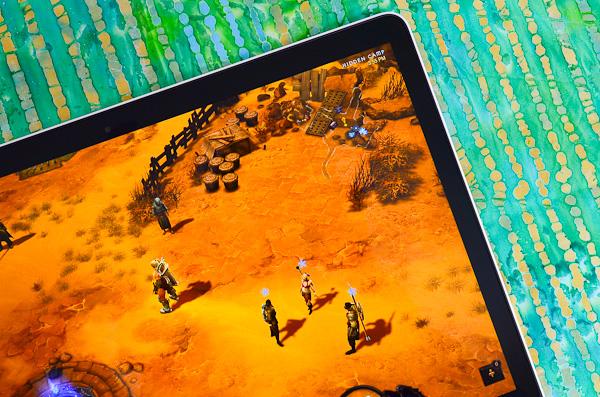The next-gen MacBook Pro with Retina Display Review
by Anand Lal Shimpi on June 23, 2012 4:14 AM EST- Posted in
- Mac
- Apple
- MacBook Pro
- Laptops
- Notebooks
Achieving Retina
To make the MacBook Pro’s Retina Display a reality Apple had to work with panel vendors to build the panels it wanted at a reasonable cost, as well as deliver the software necessary to support insanely high resolutions. There was another problem Apple faced in making the rMBP a reality: the display pipeline of the GPUs Apple wanted to use didn't officially support scaling to the resolution Apple demanded of them. Let me explain.
All modern GPUs have fixed function scaling hardware that is used to efficiently scale between resolutions. A scaler either in your GPU or in your display panel is what lets you run non-native resolutions at full screen on your LCD (e.g. running 1680 x 1050 on a 1920 x 1080 panel). None of the GPUs used in the Retina Display MacBook Pro officially support fixed-function scaling of 3840 x 2400 or 3360 x 2100 to 2880 x 1800 however. Modern day GPUs are tested against 2560 x 1440 and 2560 x 1600, but not this particular 5MP resolution. Even 4K resolution support isn’t widespread among what’s available today. Rather than wait for updated hardware and/or validation, Apple took matters into its own hands and built its own GPU accelerated scaling routines for these higher resolutions. Fixed function hardware is almost always more efficient from a performance and power standpoint, which is why there’s some additional performance loss in these scaled resolution modes.
What’s even crazier is Apple wasn’t pleased with the difference in baseline filtering quality between the Intel HD 4000 and NVIDIA GeForce GT 650M GPUs. As the Retina Display MacBook Pro would have to regularly switch between GPUs, Apple wanted to ensure a consistently good experience regardless of which GPU was active. There are a lot of filtering operations at work when doing all of this resolution scaling, so rather than compromise user experience Apple simply wrote its own default filtering routines. Since you want your upscale and downscale quality to be identical, Apple had to roll its own implementation on both. Apple’s obsessive attention to detail really made it possible to pull all of this off. It’s just insane to think about.











471 Comments
View All Comments
parlour - Saturday, June 23, 2012 - link
Hihi, that’s funny. I found the keyboard massively preferable to that of the non-Retina MBP. It seems tighter to me.I think the conclusion of this is that you have to try the keyboard before you buy. It’s certainly a high-quality keyboard either way, so calling it “the weakest part” is pretty much nonsense. It may be the weakest part for you personally, but not for everyone.
zappb - Saturday, June 23, 2012 - link
I said "squishy" , you said "tighter", are we still talking about a keyboard? is this another marketing thing a la retina?(tm)parlour - Saturday, June 23, 2012 - link
The old MBP keyboard feels more spongy to me while the rMBP keyboard feels tighter (or less spongy) to me. Hey, this is all hard to describe, we are all using strange words.So, no. I do not share your impression.
Omid.M - Sunday, June 24, 2012 - link
The key travel is maybe 30% less travel than the regular MBP. It's just like the Air and I can't stand it. You have to change HOW you type, unfortunately because there's little bounce back.I'm also disappointed in the GPU. There's definitely lag. I think we have to wait until Broadwell—2014 WWDC?—to see a 3rd gen rMBP that's truly polished.
The OWC video is totally misleading; there's no way the experience is smooth with 3 displays (4 total including the laptop).
gorash - Saturday, June 23, 2012 - link
Sounds like yet another overhyped Apple product (screen). "The screen is life-changing! It has changed my life! I can't look at any other screen in the same way now! Now I am more productive, I have more friends, and I've lost 20 pounds, thanks to the amazing Retina Display!". It was the same with the iPad 3. People were overhyping the Retina display, and everybody was saying how amazing and gorgeous and groundbreaking and life-changing the Retina display was. Then I actually saw it and I was like "Yeah it looks a little sharper, but it's nothing groundbreaking or anything".So yet again, people are getting overly hyped about yet another Apple product. Sure it may be a good product, but people act like it's the second coming or something... lol.
lukarak - Saturday, June 23, 2012 - link
For me, it's not the sharpness, it's the ability to use multiple 'resolutions' (non-native) viably, which provide different levels of screen realestate. I like that part of the equation much better than the increased sharpness, but i guess some people will also have use for it too.KoolAidMan1 - Saturday, June 23, 2012 - link
On top of increased sharpness, the color and contrast is the best I've seen on any laptop. It honestly competes with some of the best IPS desktop monitors I've seen. Fire up Aperture, it is pretty remarkable.The thing is a godsend for photographers and other professionals who work with images.
lukarak - Saturday, June 23, 2012 - link
I use macs for software development, so i don't really care about that, but it is still nice to have a better quality screen, sure.DeciusStrabo - Saturday, June 23, 2012 - link
The Thinkpad T530/W530 1080p is arguably better outside of the resolution - not IPS, but very near the same quality. And it has a 95 % sRGB gamut.inplainview - Saturday, June 23, 2012 - link
Here's and idea for you... Don't buy one.... Now isn't that revolutionary?